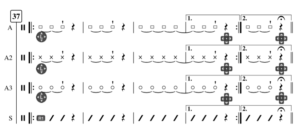Composer: Joo Won Park
Performers: Jacob Joslin, Gavin Langley, Alex MacColl-Artrip, Sean Monaghan
Scores and info: https://joowonpark.net/sevenbirdwatchers/
Tutorial: https://youtu.be/FK58MvomSlI
Seven Bird Watchers is an electronic ensemble piece featuring synchronized tempo change and graphical notation. The pre-recorded audio file syncs all drum machines to seven sections of accelerando and ritardando. The performers’ task is to change the parameters of the drum machine according to the notation.
Compare EMEWS’ performance with my multitrack version. I like EMEWS one more!

